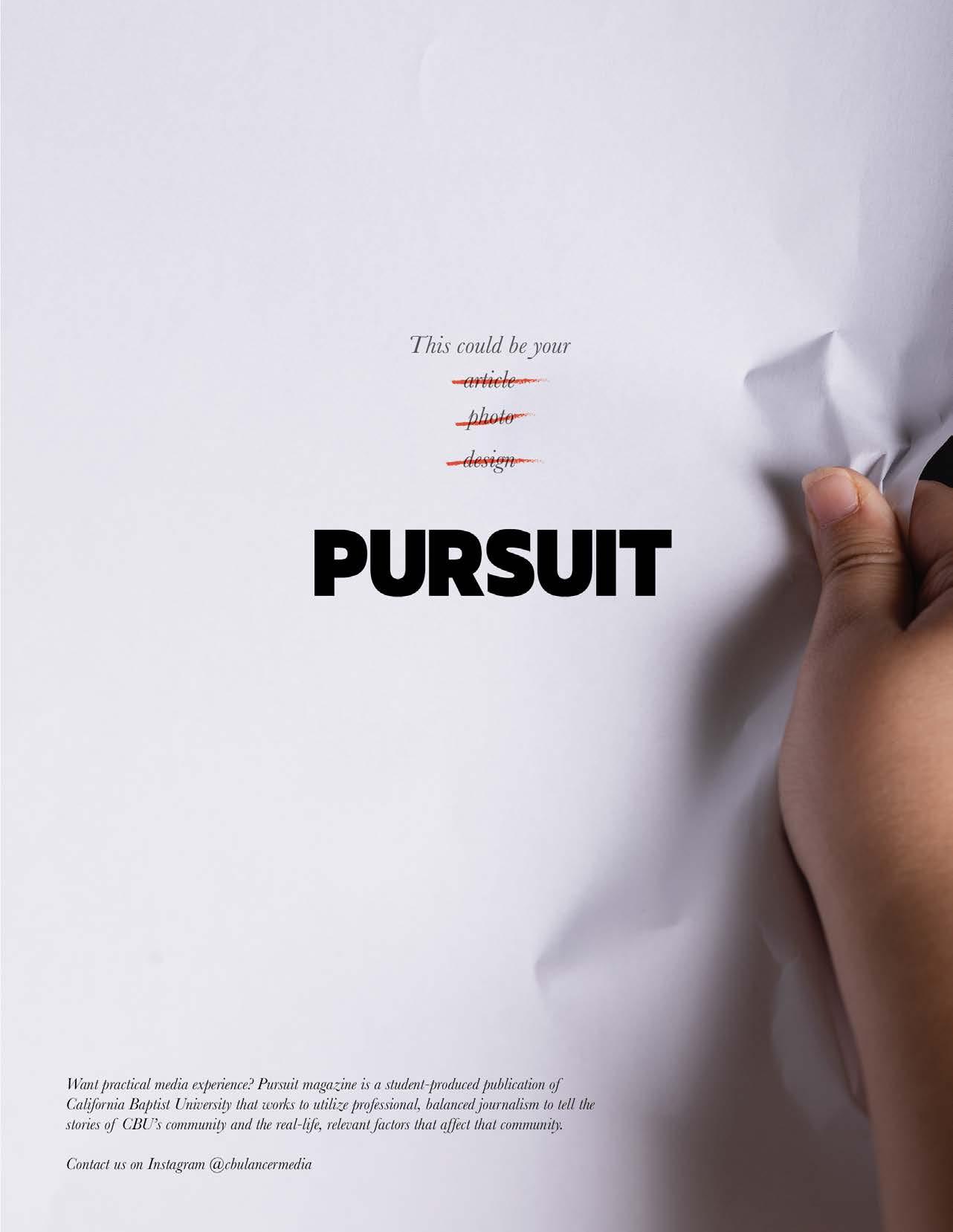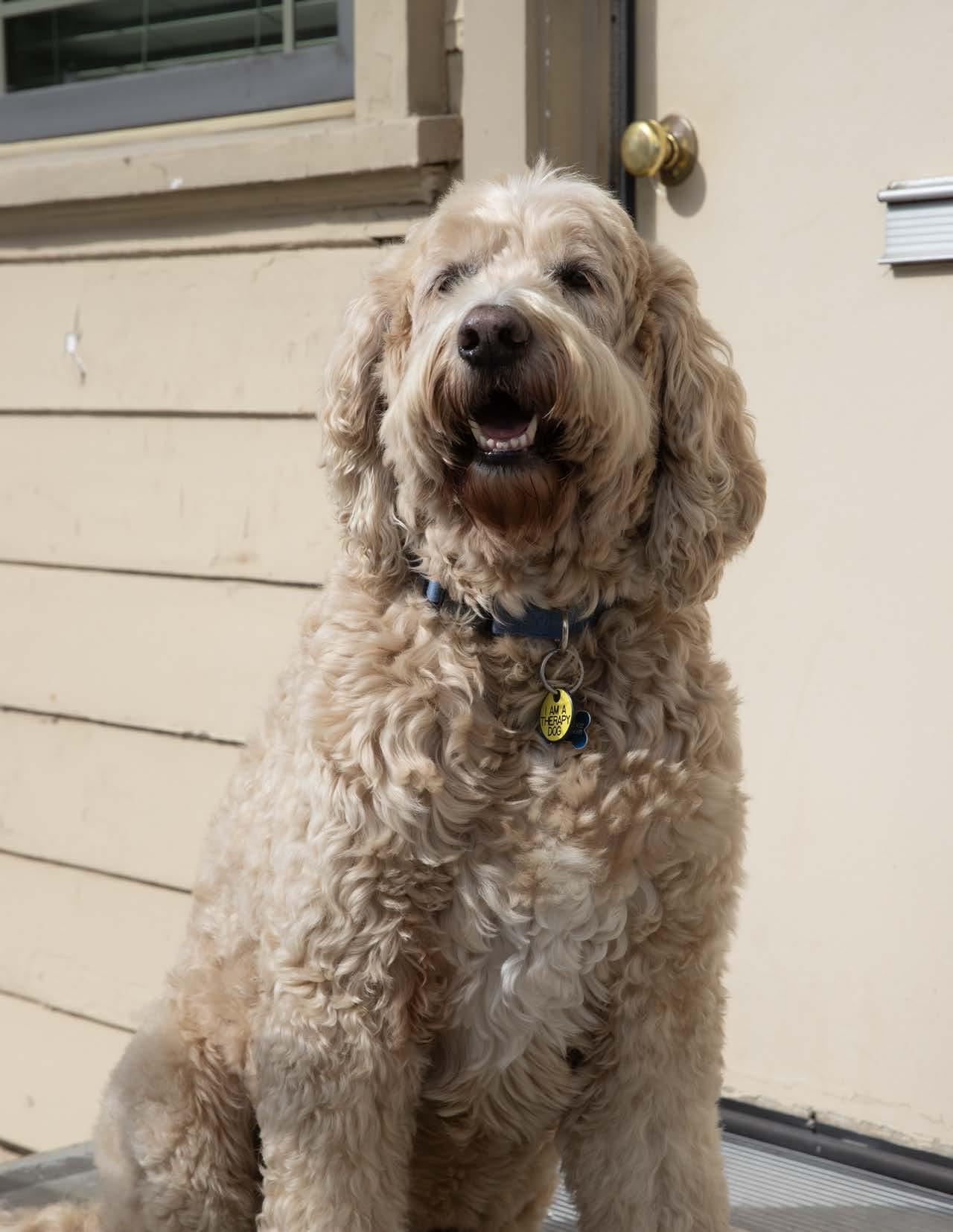Melodies Into Memories

A Photo Series: National Parks
The Workplace, Home and Hard Work
Helping Hands: Breaking Ministry Barriers Through Sign Language
The pursuit of truth: To show students the wide range of experiences life has to offer.


Melodies Into Memories

A Photo Series: National Parks
The Workplace, Home and Hard Work
Helping Hands: Breaking Ministry Barriers Through Sign Language
The pursuit of truth: To show students the wide range of experiences life has to offer.

DON’T PLAY WITH SHARP OBJECTS? ZIPPORAH MARSE EXPLORES THE COMMUNITY OF SOCAL SWORDS. TO READ MORE, TURN TO PAGE 31.
PHOTO: CHARISSA GRAVES
Rugar The Great
Dear 2024 Graduates
Melodies Into Memories
Why We Should Eliminate the phrase “the customer is always right”
SoCal Swords From Hood To Hope
The Workplace, Home and Hardwork
Helping Hands: Breaking ministRy barriers through Sign language

How do you say goodbye when you don’t want to leave? I’m sure I’m not alone when I say I don’t like change — but this semester is still full speed ahead. Like many previous Pursuit editors, I, too, have rewritten this note a few too many times.
My first draft of this note seem to boil down to thank yous and encouraging quotes, as I pushed down the thought of saying goodbye. But I have just too many memories, amazing friends and supporters to shove into a short hundred words.
Throughout my time here at California Baptist University, I have grown and experienced far more than I ever thought possible — far more that God has blessed me with than I thought possible.
In my three years at Lancer Media Group, it has become apparent to me that growth is not linear. It requires a robust support system that will inspire me constantly to accept the challenge that will get me out of my comfort zone.
As you continue to live out your life at CBU, I pray you all fully enjoy it, get out of your comfort zone and continue to grow into who you are supposed to be.
Remember to see what CBU has to offer: Rugar the CBU therapy dog, study abroad opportunities, personal faith walks or actively walking in your faith through the everyday tasks of an administration task or retail job.
Remember to see what the world has to offer: a new hobby like swordfighting, different cultures, investing in a journey through recent trends or understanding why we love specific music for certain moods.
I hope this issue of Pursuit gives you a glimpse of how to find a new interest, how to try new things and how to truly live life to the fullest.
If I think back to when I applied and inevitably came to CBU, there was not one specific dream that I was planning for my next four years. I knew I would go to classes and work a part-time job, but I had no idea the friends I’d make along the way, the spontaneous day trips I would partake in or the love I would have for CBU by the end.
While undergrad journey may be over, I won’t forget what I have learned in the last four years.
Thank you to LMG, to readers and to my family and friends. Most of all, thank you, Jesus. What a blessing it has been to create for your glory.
Let it all be, only for thee.
A

1 You, God, are my God, earnestly I seek you; I thirst for you, my whole being longs for you, in a dry and parched land where there is no water.
2 I have seen you in the sanctuary and beheld your power and your glory.
3 Because your love is better than life, my lips will glorify you.
4 I will praise you as long as I live, and in your name I will lift up my hands.
5 I will be fully satisfied as with the richest of foods; with singing lips my mouth will praise you.
6 On my bed I remember you; I think of you through the watches of the night.
7 Because you are my help, I sing in the shadow of your wings.
8 I cling to you; your right hand upholds me.
9 Those who want to kill me will be destroyed; they will go down to the depths of the earth.
10 They will be given over to the sword and become food for jackals.
11 But the king will rejoice in God; all who swear by God will glory in him, while the mouths of liars will be silenced. (NIV)
psalm of David. When he was in the Desert of Judah.

DESIGN: HANNAH DAILY
PHOTOS: NATALIE TANAKA & JOSSELYN GUILLEN
WORDS: ZIPPORAH MARSE
Out at the edge of campus, on the corner of Magnolia and Adams, lies the superhero of the College of Nursing — often in his favorite dog bed. Rugar, the college’s therapy dog, is loved by all nursing students. He brings smiles to anyone who passes him and raises spirits inside and outside the classroom. First trained and brought to California Baptist University 10 years ago, Rugar has been a part of thousands of nursing students’ lives.
While up late studying, a group of first-semester nursing students all jumped to talk about their favorite on-campus dog. Alma Gonzales gushed about the time she was able to fill his water bowl, while Dalia Lepe admitted to wanting a dog just like him. Emily Hernandez wished that Rugar’s presence at the school would be more widely known and that more people could meet him.
Though not everyone at CBU knows about Rugar, those who do love to talk about him and the impact he has had in his decade on campus.
It all started when a CBU faculty member found a little black Chihuahua and named it Moses. Because of this dog, a question arose: Could the College of Nursing keep a therapy dog? Thankfully, the answer was yes. However, somebody had to be trained on how to handle therapy dogs. That task was left up to Dr. Juliann Perdue, professor of nursing and associate dean for Program Effectiveness.
“I was kind of elected, and I had no problem with that,” Perdue says. “So, I took a course ... and I became a
certified human-animal intervention specialist.”
By the time Perdue received her certification, Moses the Chihuahua was out of the question for a potential therapy dog, though he is now a loved household pet. He was considered too excitable, which was sad for those who wanted to work with him, but was beneficial for Perdue since it taught her what kind of dog she should look for. This, of course, set her on the journey that would lead her to find and adopt Rugar.
Since poodles don’t shed and golden retrievers are loyal, friendly and family-oriented, Perdue set her heart on a goldendoodle for her therapy dog. The decision had come down to Rugar and his puppy sister, but Rugar’s calm disposition won him the job. After enrolling him in training at four months old, Perdue was proud to see Rugar become a certified therapy dog at just 13 months old.
Since then, Rugar has become an instant icon among the Nursing College and beyond. As much as his job is to introduce therapy dogs to students, he also works as one with Perdue by going with her on hospital visits to lift the spirits of the patients.
“We walked into this one gentleman’s room, and he had had surgery, so he was

 Isaiah Arteaga, sophomore nursing major, affectionately pets the friendly Rugar.
Isaiah Arteaga, sophomore nursing major, affectionately pets the friendly Rugar.
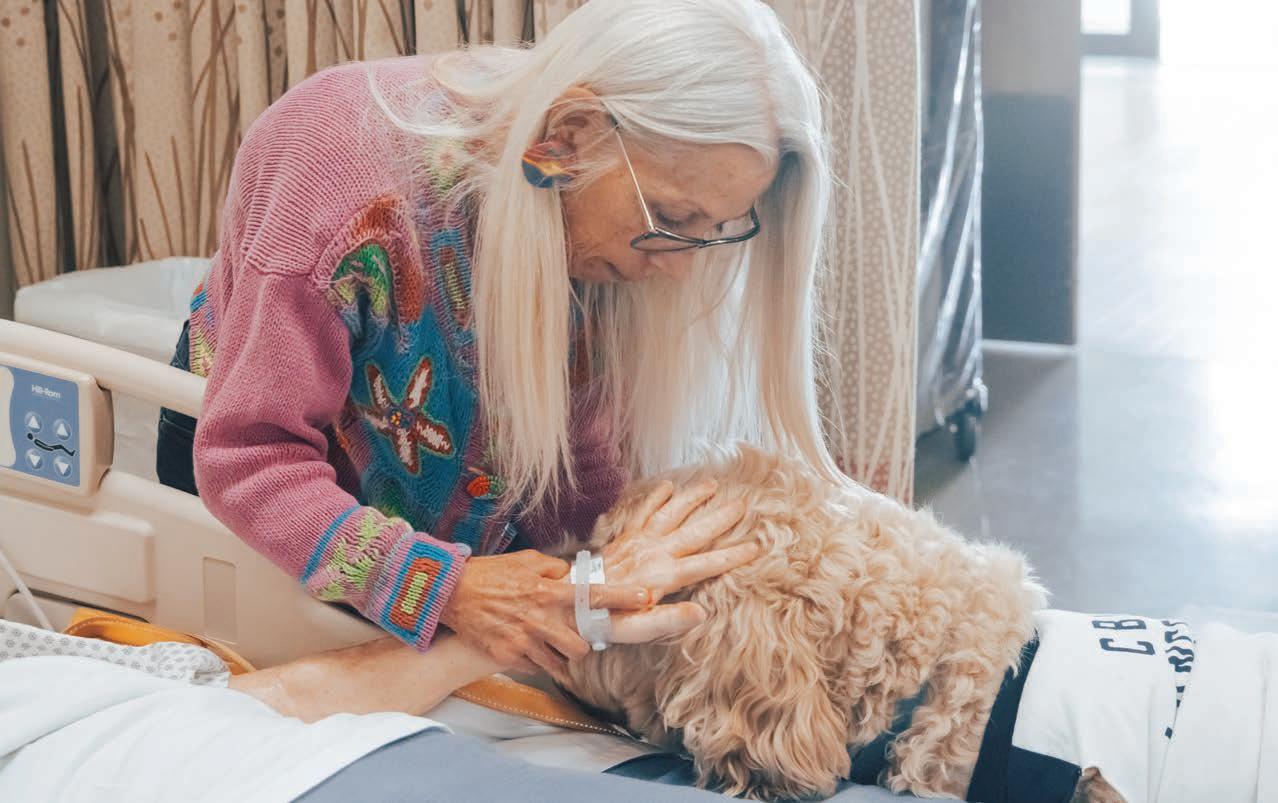
out of his bed in a chair,” Perdue says, sitting up in her own chair to demonstrate. “He’s sitting in this chair, and he’s just really stiff. You could tell he was not comfortable. He was in pain. So, I knock on the door and ask if he’d like a pet visit. He kind of nods his head, so Rugar and I walked in and” — she patted her lap with a smile — “he put his head right here. All the man had to do was lift his arm and start petting his head.”
The man’s shoulders dropped and his face relaxed. Perdue saw the beginning of a smile.
For those ten minutes, we were there and helped relieve his pain and anxiety.
-Dr. Juliann Perdue
Perdue has many stories like this, the moments of magic Rugar can work by simply making a connection with a patient. His ability to comfort those who are isolated or in pain is beautiful, and a good example of how therapy dogs positively affect the world around them. “It really lifts your heart,” Perdue says. Rugar also gives Perdue the chance to evangelize through their work. When Rugar does what he does best, Perdue gets the chance to offer a prayer for them and their family. There are so many ways



in which Rugar can touch a patient’s life and leave them better off than they were before, she says. In this sense, Rugar acts as a model for many nursing students — a symbol for them to strive to replicate in their own interactions with patients.
As good as he is at his job, Rugar is also good at being off the clock. When he’s at home, Rugar seems to be an expert in “just chilling out.”
“When he gets really excited is when he wants his breakfast and dinner,” Perdue says. “We feed him twice a day, and he bounces around and sits up; he can’t wait. He is food-motivated.”
Rugar’s relationship with food is one of the many things specified on the back of his iconic trading card that Perdue made for him when he was around 5 years old. He is wearing his little

bandana on the front, and fun facts about him are written on the back. Even today, Perdue has many of these around in her office. It serves not only as a nice introduction to Rugar but also as proof of his status as CBU’s own superhero.
In October of last year, he celebrated his 10th birthday on campus with a cupcake party — foodmotivated Rugar got his own doggy cupcake — and will soon celebrate his retirement alongside Perdue. Rugar has gone through many stages of his life at CBU and has seen the campus through many of its own stages of expansions. Although the College of Nursing is sad to see him go, Rugar has done good work for CBU and has earned some nice retirement time.
As Perdue said, “It’s time for him to just be a dog.”

Rugar and Dr. Juliann Perdue share a special moment together.
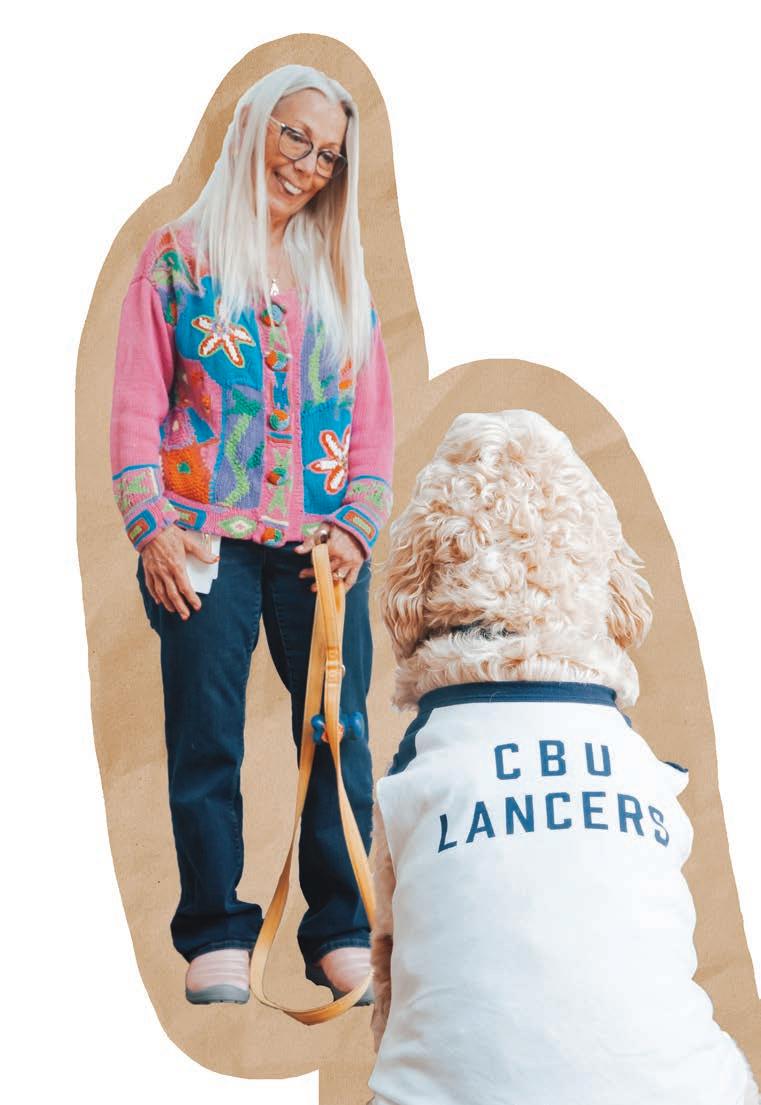






Angel babies God gifted us with two a pair of two that match a pair of socks in the color blue a pair of socks that are brand new though socks get lost those perfect blue socks. split apart.
a small blue sock missing his match a blue pair of socks separated, detached. reunited one last time.
gifted one last moment as one pair granted memories to heal broken hearts. angel babies, God gifted us with two angel babies the socks that were both blue separated a final time
Angel baby our blue who faded to white Angel baby our white who’s taken flight
Angel baby blue who grows without his pair
His pair now white who’s bond they share and though short lived and unaware our one blue still has his pair though mismatched one blue one white still a pair that are alike our angel babies, God gifted us two God thank you for our two now that one’s with you he can watch over his pair blue.
The time has come when we have to actually answer, “What are your plans after graduation?” We can no longer hold off answering by saying, “I don’t know.”
California Baptist University’s Grad Fest, where seniors pick up their cap and gowns, has arrived and is reshaping the minds of graduates as they realize commencement is just around the corner. Navigating studies and potential job prospects looks different for every graduate as they balance the fine line of submitting future plans to the Lord and pursuing actions to ensure a job or graduate program after graduation.
Isabelle Ray, senior creative writing major, has been a follower of Christ for almost 10 years. She dedicated her life to Christ at 12 years old and now Christian values guide her life.
“It was really important to me to go to a Christian school so I could try and grow a community ... and CBU, at the time [and] that I could find, was the only Christian school that had a creative writing program,” Ray says.
When Ray arrived in her first in-person creative writing class, her professor encouraged her in her writing even when Ray did not believe her personal short story assignment was very compelling. Her story was about a memory she had of when a classmate was struggling with one of her parents leaving for the weekend. Ray’s father serves in the military and, therefore, frequently went months and years without her dad being home on a day-to-day basis. It affected Ray when her classmate was expressing her experience and wrote about years later for class. The following class session, Ray’s professor told her she had cried reading her assignment.
“Knowing from the minute that I stepped onto campus and wrote that first mini-story of my own life and receiving validation from someone was life-changing, and I’ve never forgotten that,” says Ray.
With the encouraging professors Ray has come across during her time at CBU, she has continued to pursue her goals for her future of
writing stories for missionary kids, also known as MKs. Ray has put her efforts towards applying to potential jobs she is interested in after graduation and has thought of ways to reach military kids.
In her hunt for plans after college, Ray is researching and applying to many places to work. “Currently, I am focused on either writing content or editing content, so I have been looking at Christian companies, specifically, to see if I can make my way into the company and then see if I can encourage them to focus on more diverse resources,” Ray says.
As students plan their futures according to their purpose, the CBU Career Center helps students by organizing Career Fairs, hosting resume-building meetings, scheduling mock interviews, and praying alongside students. Career counselors are a built in resource for students to learn how to be successful in their season of finding a job or internship.
Bethany Anich, career counselor, talks with students each week, aiming to assist with any questions students may have when figuring out their future.
“[Students] will come in and say, ‘I don’t know what I want to do” but I always think they do. So I’ll ask them, ‘Do you like math?’ or ‘Do you find doing an exposition on William Shakespeare attractive?’” Anich says. “They kind of know already. Really, in the Career Center, what we do is partner, and we pull that thread.”
“Knowing from the minute that I stepped onto campus and wrote that first mini-story of my own life and receiving validation from someone was life-changing and I’ve never forgotten that.”
- Isabelle Ray [senior creative writing major]
Walking into the Career Center can seem daunting, especially when students do not feel they know where they would like to take their education, but it is important to know that the Career Center is a resource for current students and alumni that provides assistance, opportunities and advice.
“There are a lot of resources [in the Career Center], and I think students can be a little afraid: ‘A mock interview is scary’ or ‘Having someone critique my resume is scary,’ and it is, a little bit. They have to be willing to put themselves in a vulnerable spot,” Anich says. “Our goal is never to tear students down, it is always to build you up.”
The Career Center encourages students to research what sounds interesting to them and have an open dialogue to learn what makes sense for them. Picking the right job right out of college can add stress to students who feel that they need to land a dream job right after graduation.
“I think praying alongside students is a big role that we get to be a part of, and also just reminding them that if it’s not a ‘go,’ to look at that as experience God has given you to find what you do like, what you don’t like,” Anich says. “It is still a professional opportunity to grow in.”
Seeking God’s plan and actively working towards your future go
hand in hand. If students don’t apply for jobs, then they will not get a job, and if students are not looking to the Lord for guidance, they might miss their calling.
For students who are not looking for a career but to further their education, there are steps to ensure one’s path heads in that direction. Olivia Dyke, senior biomedical engineering major, plans to go to graduate school and is applying to universities throughout her last semester at CBU.
Dyke plans to get her Ph.D. to pursue her passion of working in the biomedical engineering field and has applied to eight grad schools across the United States.
“We are going to do our best, and let God do the rest,” Dyke says. “I think not limiting myself to one location and applying to [hard to] reach schools as well. Because who knows if I am going to get in or not, but I’m giving it to God and saying, ‘I’m not going to limit you because I know you are more sovereign and more powerful.’”
Submitting your plans to the Lord includes even little things, such as asking God where you should eat. It means praying over the decisions you are pursuing.
“It’s a daily heart posture,” Dyke says. “‘God, I’m going to give this to you.’”
Dyke knows she wants to go to grad school, but she also knows that if it is not God’s plan for her, she will adjust and embrace where she is being led.
Graduate, no matter if the next step is a job or more schooling, and know that nothing is permanent. If you like where you end up next year, keep seeking your path there. If you end up somewhere you do not want to be, there will always be another chance for you to try again or move on to the next part of your journey.
 Junior sociology major Taryn St. Amant photographed with her favorite albums.
Junior sociology major Taryn St. Amant photographed with her favorite albums.

Have you ever related to a song so deeply that you thought it was written just for you? Has the perfect song played in the moment you needed it most? From screaming Taylor Swift during a breakup to dancing to throwback hits, the right song can make any moment emotional and memorable. What you may not recognize is how much music can affect your mood on a daily basis, in smaller moments. Music is rooted much deeper than most people know. Music is embedded in your heart and mind: There is a psychology and sociology of music within you. That is not to say that everyone has the same relationship with music; every person is affected by music differently, and one person’s feelings and explanations won’t match everyone else’s. Junior sociology major Taryn St. Amant has a personal connection to music, specifically folk music.
“I listen to everything pretty much, but lately, I’ve been really loving folk music,” St. Amant says. “It’s easy to listen to because it’s versatile. I can listen to it when I’m doing homework or if I’m driving. I’m a pretty emotional person, so when I listen to music I can easily connect with the artist and their message.”
Many people use music in the background of other activities, like St. Amant does. Music encourages productivity, whether cleaning, doing homework, driving or performing other daily tasks. Playing the right song can encourage you to finish a task while also enjoying it, even when it isn’t something you’re fond of.
“Music can definitely affect your mood, and there’s plenty of research to support that,” St. Amant says. “It essentially has to do with how impressionable we are as humans. If you’re listening to sad music, it’s pretty likely you’ll be sad.”
Researchers have observed that music can help infants, toddlers and babies still in the womb develop. A study at the University of Washington written by Molly McElroy examined this theory. The study consisted of “39 babies [who] attended 12, 15-minute play sessions in the lab with their parents,” McElroy wrote. “In groups of about two or three, the babies sat with their parents, who guided them through the activities.” Half of the babies participated in groups where music was played or incorporated into the curriculum, and the other half had no music. This study took place over the course of a month to test how much music affected the baby’s cognition and understanding. “Babies in the music group had stronger brain responses to the disruption in both music and speech rhythm in both the auditory and the prefrontal cortex, compared with babies in the control group,” McElroy wrote. “This suggests that participation in the play sessions with music improved the infants’ ability to detect patterns in sounds.”


Music is a steadying force. Many people perform better on assignments





All I may give you are these arms that ache to hold you.
Everything I offer is laced in the palm of my hands.
I pray what is held in my hands may fill you,
So you may eat and feel full with the soil of the land.
Let my arms wrap around you and root you here.
Let the wind billow your shirt with your feet planted in our soil.
That I may let go and you will not crumble as the earth shakes and the storms rain upon you.
And may my warm embrace be enough. Enough enough enough.

You clock into work on a bright sunny day. The weather is perfect, and not too many people are walking around your store. Easy shift... or so you thought. You banter with the customers as you ring them up. You ask one woman how her day is going; another tells you that you remind her of her grandchildren and shows you pictures of her eligible son with a twinkle in her eye.
Then, disaster strikes. A guest slams their items onto the counter as if they want to throw them at you head first. They scoff. You keep your cool, and with a smile on your face, you ask them, “Did you find everything OK today?” They glare into the depths of your soul, roll their eyes, and give you a snarky “Yes.” Somehow, it is not convincing. You scan each item and give them the total.
The customer’s eyes widen as pure shock spreads across her face. She questions why these items were not on sale when there was a sale sign.
“Sometimes items get misplaced in front of a ‘50% Off’ sign,” you politely reply.
Like any good employee, you check the signage as you’re taught to do when an item isn’t ringing up correctly. As luck would have it, the little fine print specifies exactly which item is on sale. Now, you have to decline their request to override the system. How dare you not bend the rules for an angry stranger?
Now they want your manager, the line is to the back of the store, and forced tears are streaming down their face to make it seem like you were yelling at them. You
stare blankly at the customer as they beg for something to compensate for this horrendous situation. They insult you for being “incompetent” and “hating your job” and make outlandish claims that you will probably “amount to nothing.” Then they slip in the phrase, “the customer is always right,” so they deserve to get something, anything, for free, or even this item for half the price.

But should people get what they want simply because they think they should? Thanks to Harry Gordon Selfridge, founder of the British department store Selfridges and originator of the phrase “the customer is always right,” this phrase has been around since 1909. That means this phrase has been around for more than
DESIGN: HANNAH DAILY ILLUSTRATIONS: AJ WELLS WORDS: GABI RIGGIN
100 years. Talk about out of style.
In a society where slang and phrases are constantly changing due to social media trends and new generations, this phrase has managed to keep its grip on what we as consumers consider “good customer service.”
The customer should not have that strong of a power to put that employee at risk for getting in trouble.
“ ”
ALAYNA HAYES
Those who work in customer service — retail, food service, hospitality, gas stations and more — have at least one story about a customer not getting the service they demanded, without apparent concern for the employee who has no say in the creation of a corporate policy and little to no ability to change or ‘bend’ the rules.
Customers are consistently dissatisfied. Scrolling through Yelp reviews, it’s evident that any restaurant on the map sees as many one-star reviews as fivestar. About 74% of Americans say they’ve faced a recent product or service issue, according to the National Customer Range Survey conducted by Customer Care Measurement and Consulting. That’s more than double the rate in 1976, nearly 50 years ago. You’d think that with more time and life experiences, we’d be at a point of greater

understanding customer service work.
The dissatisfaction is not just from customers, though, but from the workers who have to deal with the dissatisfaction. Employees reported that 43% of customers yelled or raised their voice about their most serious problem, which is up 35% in 2015, a significant increase for only nine years.
The amount of complaining is described is an increasingly digital phenomenon, according to the National Customer Range Survey. Over the course the last year, digital channels such as email and social media have overtaken a simple phone call complaint by 50%. Nearly 17% of Americans have personally behaved uncivilly during the past year, and 22% cited the moral decay of society as the main reason customer incivility is on the rise, according to the survey.
“The phrase a customer is always right, definitely doesn’t always apply. Because oftentimes, [customers] really don’t understand the store policies, whereas the employees are literally trained to understand all of the policies,” says Alayna Hayes, freshman elementary education major who works part-time in food service.
“Customers can take it out of proportion and just kind of twist what actually happened, which has happened to a couple of my co-workers. And it’s really not fair because oftentimes, the managers are going to look at those comment cards and automatically assume that the employee was in the wrong,” Hayes says. “The customer should not have that strong of a power to put that employee at risk for getting in trouble.”
Hayes says, at the end of the day, employees are there to do the job they were trained to do. The phrase “the customer is always right” should not hold as much
ALL PEOPLE SHOULD BE TREATED WITH DIGNITY & RESPECT. “ ”
JAILYN PATRICK
power as it does.
“I feel like that phrase does make people feel entitled in a certain way,” Hayes says. “[Employees are] just relaying policies given by their workplace. If anything, it’s just inhibiting the employee’s ability to do their job the way they’re supposed to be. And that’s why it’s so wrong that oftentimes the workplace will side with the customer. That could be really harmful.”
Of course, customer service isn’t always a war in which customers can throw the biggest fit. There are still very kind-hearted people who show kindness to everyone they encounter, and the difference is not lost on employees.
Kenia Mendoza, junior Spanish major, has three years of experience working in customer service and currently works at a car wash. She said her previous experience working at a gas station was remarkably delightful; all her regulars were the best, and she enjoyed the customers.
“Customers were always so sweet. I didn’t have bad experiences there,” Mendoza says.
The car wash introduced a slightly different group of consumers. Mendoza said the customers forget that workers, too, are human beings with inner lives and stressors of their own, even if they are paid to be of service to customers.
Mendoza explained that sometimes customers will be upset if the basic wash, the most inexpensive option, doesn’t clean their car all the way. She has to tell them it is because they chose the least thorough car wash, but customers continue to argue.
“The rewashes there — we can’t just hand them out. It counts against us,” Mendoza says. “I can’t keep
arguing, and they know if they argue enough, we’re just gonna give them a wash,” Mendoza continues.
Whether you used to work in customer service or it is where you currently make your living, working in customer service can change your perspective on how you react when a restaurant is out of your favorite soda or you don’t want to wait in long lines at a clothing store. For Mendoza, her experience has changed her.
“I know how it feels. It did change my perspective a lot,” Mendoza says. “Now, I am even more patient.”
The experience isn’t much different for many customer service workers across the board, even someone in the field for nine years.
Jailyn Patrick, CBU alumna, worked in customer service as a team member, a barista, and a server. Her experience parallels similar difficulties
that the phrase “the customer is always right” enforces.
“I tried not to cry but had to hold it together so that I could continue serving other guests,” Patrick says. The phrase “the customer is always right,” Patrick says, overshadows the human aspect of excellent service.

“There have been many times this has happened, but one that I can specifically think of is when a customer was putting his name on our waiting list. I told him that if he left and we called his name three times with no response, he would be taken off the list. This exact scenario happened, and when he returned, he yelled at me and called me several terrible names,” says Patrick, echoing the feelings of others who have found themselves in similar moments.
Echoing the feelings of others who work in customer service today and her feelings of disregard at that moment.
“I think that a better practice for companies is to train their employees on social skills and awareness, as well as that all people have value and should be treated with dignity and respect,” Patrick says. “This attacks the root of the issue, which is that all people deserve to be treated respectfully, even if they are not showing you respect. This also allows for you to stand up for yourself or someone else if they are being mistreated, and to find justice of truth rather than just putting a blanket statement over the situation like, ‘the customer is always right.’” Whether you’re clocking out at end of your shift, or you’re walking in as a customer in a restaurant or grocery store going through your day, understand that real people are really working to earn a living just like the rest of the world.
Is the customer really always right? Or did we let that phrase justify disregard for the person on the other side of the counter with a nametag? Many customer service workers have experienced the belittlement of their existence when they are in their uniforms. Customer service can be a simple and kind interaction between strangers and not an experience that leaves them feeling like less than others — nobody deserves that.

With a simple parry, step and lunge, swordfighters all around the world learn to make the same moves as medieval knights did hundreds of years ago.
Historical European Martial Arts (HEMA) is a method of studying and practicing the art of sword fighting in a historically accurate way. As it is a newer martial art, not many people know of its existence, let alone how to begin their journey to expert swordfighter status. Luckily for CBU students, there is a HEMA school less than an hour away dedicated to teaching anyone and everyone.
SoCal Swords, located in Orange, was opened in 2021 by owner RJ McKeehan. After getting into HEMA when he was in college, McKeehan has spent the majority of his life studying historical swordplay. This martial art has given him unique
ways to stay fit, intellectually stimulated and connected to his community. Through SoCal Swords, McKeehan strives to give others the chance to engage with HEMA and receive the same perks for themselves.
“Everybody wants to play with swords,” McKeehan explained. “Give people some wrapping paper tubes and they’re going to start hitting them together. It’s pretty natural. I think the ultimate version of that is actually getting metal swords and hitting each other with them and trying to figure out how they were really used.”
In a time where group activities like axe-throwing have gained popularity, SoCal Swords introduces layers of history and craft. Strewn about the store there are tons of books and manuscripts on different medieval swordfighting techniques that are meant




“That was a big thing for me. I wanted to make a space where people could have friends and community and feel like they’re a part of something.”
- RJ McKeehan [SoCal Swords Owner]
to be studied. Some books are for sale at the official SoCal Swords store while some are a part of McKeehan’s own collection that he’s developed over his 15 years of studying HEMA. SoCal Swords, and HEMA in general, is committed to teaching only real, accurate sword fighting techniques from specific moments in history. As employee Sean Dickenson said, “If there’s documentation of it, we teach it.”
Because of HEMA’s emphasis on history, self-proclaimed “nerds” have come out of the woodwork to engage with such an intellectual topic. When asked, McKeehan specified that HEMA had a large boom in popularity around 2015, which was mainly due to a large nerd community finding interest in studious sword fighting. Not only have history buffs been intrigued by HEMA, but fantasy fans and people with hobbies like Dungeons & Dragons (D&D) and Live Action Roleplaying (LARPing) have taken an interest in learning the martial art. Almost every Saturday evening, the crew at SoCal Swords put on community nights to bring everybody together. They host everything from a monthly D&D campaign and Magic: The Gathering tournaments to board games and arts and crafts nights.
“That was a big thing for me,”
McKeehan explained. “I wanted to make a
space where people could have friends and community and feel like they’re a part of something.”
After college, many adults struggle to find friends with whom they can have spontaneous fun. McKeehan says that he sees SoCal Swords, and HEMA in general, as a kind of club for adults in the working world. For any CBU students planning on staying in Southern California after graduation, spaces like this offer a place to stay connected to a community. One of the hardest things about getting into a “club” or any type of new activity as an adult is getting through that beginner stage. Sometimes people don’t like to try new things once they’re grown because they fear they won’t be good at it and others will judge them. At SoCal Swords, this couldn’t be further from the truth. Not only do students learn alongside many other beginners, but the teachers of these beginners classes cultivate a community of support.
McKeehan said he loves seeing beginners slowly get better over time in his courses. He notices when people
become more comfortable in their body and their movements and the satisfaction that results, both for the teacher and the student. Through HEMA, students gain better balance and control of their bodies, which is physically beneficial both inside and outside of the classes.
Because HEMA isn’t a common lifelong hobby, as opposed to playing an instrument or a sport, it may feel less awkward to begin later in life, helping it feel welcoming and rewarding to all who take an interest.
So, picture this: You’re about to graduate and need to focus on starting your new career, but you’re worried about losing touch with your college friend group as you all go in different directions. You don’t want that to happen, so you come to them with a proposition: You set aside one day of the week and buy the beginner course at SoCal Swords. Now, not only are you staying connected to your current friends, but you’re making new connections and building new skills at the same time. A few months down the line, you and your friends have all gained better strength and balance, and you’re all spending time together hitting stuff with swords.
You couldn’t ask for a better hobby.



DESIGN: HANNAH DAILY
PHOTOS: JOSSELYN GUILLEN & NATALIE TANAKA
WORDS: NATALIE TANAKA

“What do you want to be when you grow up?”
For many children across America, this common question is immediately met with a plethora of excited answers: an astronaut, a teacher, a veterinarian, a chef.
The list could go on and on.
But for Dr. Damon Horton, professor of intercultural studies at California Baptist University, his response to this question as a child was quite different.
His answer was: nothing.
“I didn’t really have any ambitions or dreams as a child. I tell people — and I know it sounds morbid — but I really didn’t think I was going to outlive my teenage years. I didn’t think I’d live to see 18.”
Born in Kansas City, Missouri, Horton grew up in an environment that was ridden with racism, poverty and gangs. He quickly got involved in street life as a young boy and grew accustomed to violence, addiction and death. At the time, he saw no other option, no other alternative in life.
“Growing up in poverty, I would get money any way I could, as fast as I could, and I’d spend it faster than I got it,” Horton says. “I was living the fast life as much as I could because I thought that would be it.”
Dreamless and directionless, Horton lived for himself and his desires and never considered pursuing academics.
“I never had any definitive drive to do anything specifically,” he says. “I never thought I’d go to college. I never thought that I’d end up being a professor at a university or anything along those lines.”
As Horton spoke these words, I eyed the nameplate on his desk, which proudly read, “D.A. Horton, Ph.D.” And I marveled — and wondered — how did he get here?
AND MY HEART WAS BROKE BY THE LORD…I was ready for a change. And ever since, I never went back to the same type of life I was living.
“ ”
DR. DAMON HORTON
The first spark that lit the fire of change in his life, Horton said, occurred on a Sunday night: March 31, 1996. He had run away from home and had been out on the
streets by himself for over a week, eventually getting caught up in a situation with the police. He was only 15 at the time.
That day, Horton was faced with a paramount decision. He realized that if he continued in his current lifestyle, his path would ultimately lead to a life behind bars — and that was a life he didn’t want. He returned home and told his parents that he wanted to change the way he was living. That night, he attended a service at his family’s local church.
Growing up in poverty, I would get money any way I could, as fast as I could, and I’d spend it faster than I got it. I was living the fast life as much as I could because I thought that would be it. “ ”
DR. DAMON HORTON
“I went, I sat on the front row like I always did, and heard the gospel. And my heart was broke by the Lord,” Horton says. “It was the first time that I was impacted by the gospel, and I didn’t want to live the way I was living anymore. I was ready for a change. And ever since, I never went back to the same type of life I was living.” After graduating high school, Horton threw himself into ministry and also decided to enroll in community college. But, being the first in his family to go to college, he had no idea where to begin. Academia was an entirely new field to him, one in which he struggled to find belonging.
“When I began college, my initial major [I] declared was business, because I had no idea what I wanted to do,” Horton explains. “I remember once I was sitting on the sixth floor of a building in my community college, and I could oversee all my neighborhood. I could see the same people on the streets doing what they were doing, and I was just sitting there like, ‘Man, that’s where I’m from.’ And it’s a whole different view of this neighborhood from up here in this space. I don’t even feel like I belong here. I feel like I’m supposed to be out there with them. But I know that’s not who I am or where I’m going to end up.”
It was during this uncertain time that Horton’s first dreams and ambitions began to appear, leading to changes in majors.
“I never really had any ambitions until my mid 20s, when I looked to finish my undergraduate degree and felt God calling me to serve as a pastor in LA,” he recalls.
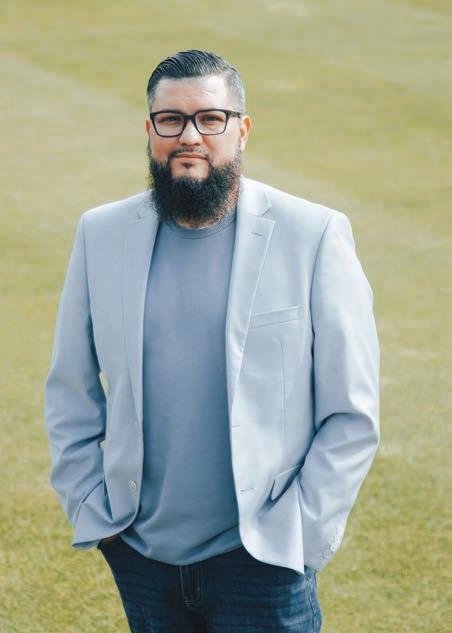
But even after graduation, his dreams continued to change and mature with time. After serving as a pastor for a time, he began to realize a new calling: the possibility of pastoring but also having a full-time job as a professor. This idea of bringing the church and the classroom together was a perfect mix for him.
At 37 years of age, Horton realized his purpose. “I finally see what it is that I’m called to do,” he recalls.
Horton went on to earn his Ph.D. and plant a church in LA. In 2017, he was contacted to do a Chapel service at CBU, and later, an opportunity to teach adjunct that fall opened up.
“I prayed about it, talked to my wife about it, talked to

Dr. Horton’s nameplate shows how far he’s come.
the other leaders in the church about it, and presented it to our whole church,” he says. “I told them that it had always been my heart to start a church in LA, but eventually step back to let the local people run it. The church gave me the green light to apply, and from there, the Lord opened the door.”
Now in his fifth year of teaching at CBU, Horton says it is his dream job.
“I never hate coming to work. It’s hard to leave some days,” he says. “The conversations I have with students are life-giving. My greatest joy is seeing students wrestle with material and then have ‘ah-ha’ moments where they get it and are able to communicate it in their own heart language.”
Throughout his journey, Horton did not have an easy ride. He dealt with family illness and lost multiple loved ones. He also has had continuing struggles with mental health, including depression, anxiety, survivor’s guilt and imposter syndrome. But through it all, Horton is unwavering in his commitment to give back to others.
“It’s a battle I still wrestle with, but it keeps me grounded, keeps me humble, keeps me broken and keeps me focused,” he says. “I take my experiences and I take the memories of everyone that I lost and I realize that I’m still here, and I need to do something … to help people where they are.
In the classroom, Horton sees it as his mission to pass on what he has learned.
“A lot of things I learned later in life. I want to introduce them to my students at 18, 19, 20 so they don’t have to wait until they’re 38, 39, 40 to learn it,” he says. “I’d rather they learn it now so they can work with it, master it, and then they’ll be three times ahead from where I am by the time they get to my age. And that’s the goal. That’s how I pay it forward, that’s how I give back — by constantly giving myself and the whole of myself. I learned this by looking at the example of Christ — this is what the Scriptures call us to do.”
My greatest joy is seeing students wrestle with material and then have ‘ah-ha’ moments where they get it and are able to communicate it in their own heart language. “ ”
That’s how I pay it forward, that’s how I give back — by constantly giving myself and the whole of myself. I learned this by looking at the example of Christ — this is what the Scriptures call us to do. “ ”
DR. DAMON HORTON
Walking out of Dr. Damon Horton’s office, I couldn’t stop thinking about his story — the hopelessness of his youth, the change and the growth, the struggles and the hardships, all of which shaped him and continue to fuel his life’s work.
Maybe your story doesn’t look like Horton’s, but perhaps you’ve had similar moments of hardship, doubting, struggles and uncertainty. Maybe you’ve wondered where
to go in life. Maybe you aren’t sure of what you’re supposed to do yet. Maybe you don’t know what to major in or what career to pursue — or maybe you do know, but you feel like you’re lagging behind everybody else.
If that’s you, Horton shared one more piece of advice. “My wife always says comparison is the thief of joy. You might be comparing yourself to peers who come in knowing what they want to major in, who’ve known since they were little — and there’s nothing wrong with that — but that’s not everybody’s story. Some people are like me. I got my undergrad in one thing, my master’s in another and my Ph.D. in another. Students ask me, if you had to do it all over again, would you do it the same way? And I’m like, absolutely not!” he said, laughing.
“But I didn’t,” he continues. “We change majors, and that’s OK. We discover ourselves as it relates to the failures and mistakes that we make. Don’t compare yourself to anybody, don’t beat yourself down. When you entrust your whole life to the Lord, he has a way of making every experience, no matter how hard or how helpful, part of your story and journey.”
That journey is a story with ups and downs, moments of laughter and moments of tears. It’s not always easy, but through it all, God is shaping us and changing us into the people he wants us to be. So, take a step back. Breathe. Remember that your life is not defined by one single moment, one single decision, or even one single period of time. Horton’s wasn’t. And neither is yours.

Find us in Lancer Arms 56: the International Center. Turn right, left and right again. Daphne is at her standing desk, texting a prospective student on WhatsApp. Josh is on a Zoom call. Joe taps at his keyboard, Outlook tabs filling his screen. Grab a chocolate from Deborah’s desk. Rachel has her AirPods in, in full focus mode.
Welcome to International Admissions. I’m one of the four IA interns this year, and I’m excited to show you this place that has taught me the beauty of hard work.
At the end of my junior year, I found myself asking the classic question: to do student leadership or to not do student leadership? I knew that I was a task-oriented, tenacious worker, and I actually enjoyed the desk work so many people hated. Yet, at the same time, I wanted to make a difference in people’s lives. I applied to a few jobs around campus and eventually found myself at the International Center to interview for two different jobs on the two “sides” of the office. One internship was a space to spend intentional time with students and engage in ministry, another a space to accomplish tasks and be a part of the admissions team.
In some ways, it seemed like a no-brainer: I wanted to engage in ministry, and here was my chance, but after a conversation with the director of International Admissions, Joe, I realized it wasn’t quite that black and white.
Bryan Davis, dean of International Programs, shares a similar vision to what Joe Gemignani, director of IA, shared with me: “Everybody really does have a heart for the nations and a desire for this to be kingdom building,” Gemignani says. “People tend to pursue the job [in International Admissions] historically out of that heart and passion. They may have the skill set to be admissions — which is truly sales and recruiting and marketing — maybe they have that sort of business acumen and skill set, but their heart really is for what God is doing globally and building his kingdom.”
Something about this stirred in me some hope that the way my brain works has some larger meaning. Maybe a person with my skill set who loves tasks and lists and organization might have some hope of contributing to kingdom-building.
Davis continues, “We have the opportunity to bring students in, knowing that what they’re going to engage with at CBU is going to potentially make an impact in their life deeply, and maybe there is a deeper opportunity in terms of gospel and other things.”
There he touches on the heartbeat of International Admissions: our skill set,
prospective students and the gospel. The office mission statement outlines a similar idea: “We exist to serve prospective international students and families … by providing excellent content and conduct.”
The phrase “we exist to serve” always seems to jump out when I read over that mission statement. Serve. What does it look like to serve students when your job entails paperwork and processes and sales?
To Davis, service means treating prospective students holistically and with honor.
“We want to believe that we glorify God when we treat a student and a family maybe more holistically and with greater honor than maybe an experience they might get at another school,” Davis says. “I don’t know what they’re getting in other schools, but I don’t want them to walk away thinking we treated them with less dignity in your honor or love or care than another school. We want to be the best at that, and I think that’s one of the ways we glorify God.”
Taylor Brown, junior elementary education major and IA intern, says she has seen the IA counselors live out their mission to serve students.
“Just because we are not necessarily interacting [in-person] with potential students all the time doesn’t mean we can’t show them God’s grace through how we speak to them over the phone or respond to their emails,” Brown says. “The way they handle people in such a respectful way blows my mind.”
She has worked in International Admissions since September and has watched the counselors navigate unexpected situations that always seem to arise in cross-cultural work.
“The way they handle the differences culturally is so crazy to me because they just do it so well and respectfully and so calmly,” Brown says. “A [prospective] student will come in for a meeting that was not scheduled and if the counselors have time they will go and they will handle it. They don’t lash out like, ‘You didn’t make an appointment.’ They make room and they consistently prioritize the students over their own schedule … and they try their best to make them feel welcomed, even if they have a thousand other things to do.”
Like Brown describes, the gospel calls Christians into a service that treats every person with the dignity and respect they deserve as image-bearers of God. This principle applies in every area of work and can be applied uniquely in an office like IA.
“You glorify God in doing paperwork by working hard knowing that that’s an individual that He values that He might intend to go to CBU,” Brown says. “We work hard knowing that God sorts that out in his divine purpose but that
we did everything we could to make that a reality. … We work really hard at understanding what is potentially even eternally at stake whether or not they come to CBU.”
I have the honor of knowing, being friends with, and going to church with one individual who came to CBU and whose eternity has been changed by the choice. His name is Nick*. His story begins in the Middle East, all the way around the world. He realized he wanted to study abroad when his dad went to work abroad for a year and decided he wanted to go to Germany, as that was where he grew up. Long story short, the doors closed for him to go to Germany, so he set his sights on the US instead.

“I was looking at like 20, 25 universities, and CBU was the last option to choose,” he said with a laugh. “I wasn’t thinking to go to CBU at all.”
Slowly, because of the beautiful campus and sports opportunities, CBU crept up his list, and eventually, he applied. “My admissions counselor was Daphne [Kieling],” he says, “and she was a really great counselor. The communication was really smooth and easy with her. I applied to two universities, and CBU was the best with responding to me. They were so

active with me; when I asked something, they answered quickly and not after, like, weeks. With other universities, I would wait like two weeks just to get one answer.”
This part of his story takes on new meaning for me, as I have the intern insider perspective on what that communication looks like for an admissions counselor and the hard work it takes to keep up-to-date with emails. It was rewarding and exciting that that work does not go unnoticed by students.
There is a fun side to communicating with students, too. Nick shared that his first time talking with a native English speaker was on an informational video call with Daphne.
“I was nervous, but it was really smooth,” he says. “She didn’t make me feel like I had bad English, and it was great… In the beginning, I was trying to avoid video calls and just email. After [my first] meeting with her, I started preferring video calls.”
Through the hard work of both Nick and Daphne together, Nick eventually enrolled in CBU and is finishing his sophomore year as a software engineering major. He continues to tell the story of how his life has changed after coming to CBU.
“It was not easy to come here,” he says. “After I couldn’t go to Germany, I thought that was it; my life ended here, and all the

doors closed. But no, other beautiful doors opened. I saw one door close and a thousand open. … I thought to myself that God was sending me to CBU not just to study but someone’s life was going to change, either my life or someone else’s life.
“When I came to CBU, I developed and [grew] more. I wanted to really know what [Christians] believed in and not just ... judge you without understanding. I wanted to know what you believe and how you believe it,” he says. “Throughout my freshman year, I was learning more and more, and CBU was the best environment to learn in. I don’t think if I went to another university, I would get this knowledge of faith.
After he arrived at CBU, one of Nick’s friends invited him to go to church, and he found the people there to be so welcoming.

“I got to know what Christianity is,” he says. “Then at the beginning of my sophomore year, I had some questions, and I said, ‘I have all the answers, I can’t just ignore it.’ I got answers from my friends and professors and also my pastor. After I got my answers, I said, ‘Why keep avoiding it?’ I said, ‘Yeah, I want to be a Christian.’”
I love Nick’s story because it’s not your expected headline: “International Admissions changed my life.” He was just a
prospective student interested in CBU that Kieling treated with dignity, honor and care. Nick is one of many students who have been recipients of the all of the admission counselors’ faithful, relational and task-oriented work.
International Admissions has given this graduating senior a vision for entering the workforce that believes and hopes that work and gospel work can be intertwined, in any workplace. That working to the glory of God means serving individuals holistically, intentionally and with patience. Work — even dull paperwork –—can impact the kingdom eternally.
In parting, I echo Brown’s words. “I want to thank them for the fact that they have their own lives outside of work and so much to do within work but they’ve just done such a great job making the [International Center] feel like home to where it’s not just a job, like, we have like a family there. I know they probably don’t realize that we can view them and the environment there like that. I want them to know that their work does not go unseen by us.”
*Name changed for privacy purposes.
Dad, you may not have been in my life consistently, but I’m grateful to know you never left me.
With each tear that streaked down my face, you would squat down to hold me, even if your uniform was stiff against my cheek.
Even though I never would have chosen this life, I wouldn’t trade these experiences for anything.
To know that my father was gone for a good cause— to defend our family, our home, our country— is my greatest honor to bear.
Thank you for showing me how to be a proud American, for displaying selflessness when it's hard, and for persevering through every trial.
I will forever be proud to call you my soldier.


The Deaf community is the third most unreached people group in the world.
According to the United Nations, there are more than 70 million deaf people worldwide, more than 80% of them living in developed countries. Less than 2% of culturally Deaf people have ever seen the name of Jesus in their language, and even fewer actively follow him. The International Mission Board calls this community “some of the least evangelized people on earth.” Even within the American church, less than 5% of churches offer Deaf-specific ministry, according to Silent Blessings Deaf
Dr. Daniel Blair, director of CBU’s Center for Deaf Studies, points to one primary reason for that.
“The biggest one is the language barrier,” he says. “The typical pastoral response when deaf people come to the church will be, ‘Can they read lips?’ And, of course, the answer is, ‘Well, you try it.’”
Blair says this language barrier is the exact reason he began his study of American Sign Language and Deaf culture. He decided that, instead of waiting in church for Deaf people to come into a space where they have
DESIGN: MADISON KIRKLAND WORDS & PHOTO: CHARISSA GRAVES
historically not been accommodated, he would make the move to education to impact the community directly. In making that move to Riverside to teach at CBU, he also began a new life in what he refers to as “one of the most vibrant Deaf communities in the world.”
California School for the Deaf, Riverside (CSDR) is one of two schools in California specifically meant to accommodate deaf children. The Cubs, their football team, seems to have made a habit of making history. As the only Deaf school in the California Interscholastic Federation, their success in making it to a state championship game in 2021 was historic in its own right. So, when they won their first championship title in 2022, as well as their second in 2023, there was even more cause for celebration.
“Right now,” Blair says, “the Deaf community is riding a wave of popularity.” Between CSDR’s media attention and the critical acclaim of the entirely Deaf-created movie “CODA” — winner of the 2021 Oscar for Best Picture — there’s momentum for Deaf awareness.
For Jackson Brown, Deaf minister at the Grove Community Church, the Deaf community can be described as people living together in a group, understanding and supporting each other through shared experiences.

American Sign Language Ministry
Much like Blair, Brown moved to Riverside after meeting other Deaf people from around the world. “God really put that on my heart to teach more deaf people,” Brown says. “He opened that door for me to come here and work with them in the Deaf church.”
“Everyone deserves to know Jesus,” says senior history major Priscilla Moreno, who is also the president of CBU’s ASL club. “They deserve to know Jesus,” she stresses, pointing to the need for more accessibility measures within ministry. “Jesus died for them too.”
Blair did say that he sees technology gradually reshaping accessibility needs within the church. As more churches include things such as
Community

captions, the need for interpreters lessens slightly. This is not, however, a replacement for genuine, face-to-face interpersonal fellowship, which is an essential part of even non-religious Deaf interaction.
“Christian people love people,” Blair says. Because of this idea, he argues that “churches should be carrying the banner for accessibility.”
Examples of this include providing services such as captioning, but also ASL interpreted services, Deaf-oriented outreach and even congregation members making an effort to include and communicate with Deaf people.
“It’s a beautiful language,” Moreno says, taking this idea even further. and it’s something that everyone should know and learn the basics of to help bridge the communication gap between the hearing and the Deaf communities.”
Even outside the context of ministry, Moreno says knowing how to sign “could help in any situation, but if there’s an emergency and someone needs help, knowing even the basics of ASL — even fingerspelling — you can aid them.” Or, in the broader sense of one-on-one conversations, “you can have a more personal connection with them.”
To Brown, exclusion and a lack of accessibility is nothing new. “Deaf people learned over many years of experience how to live within a world that isn’t built for them. That doesn’t mean that they are broken.”
The Deaf community is rich, vibrant and full of culture all on its own. It is strong, with more than 300 different languages worldwide, and with arms wide open to those who make the effort.
“The person who does not try will never fail, but a person who doesn’t try also cannot learn,” Brown says as an encouragement to hearing people. “They need to try and learn about our language.”
There are myriad ways that the Deaf Studies program at CBU has engaged with the Riverside Deaf community since the ASL minor launched in 2019. Continued engagement with CSDR and the Grove Community Church’s Deaf ministry, as well as a public presence at events such as the Riverside DeaFestival help bring awareness to the program and what it is working to achieve while also actively working to break down the social barriers that exist between the hearing and Deaf communities.
Having attended many such events, Moreno said she has been able to interact with the community quite a bit. She said she was greeted warmly and that she is “honored and [grateful] that they were willing to share their culture with the rest of us.”
The global Deaf community remains one of the most unreached in the world. However, this doesn’t need to be the case. People can build bridges with some effort and understanding. Language is a tool, and when used correctly it can break down the walls keeping communities apart.


 Help Friend
Help Friend
Do you remember growing up and seeing commercial after commercial of an exciting new toy or gadget that caught your eye, and you’d put that on your Christmas list or ask for it for your birthday? It’s not so different from how we ask for things now, except this happens every day.
Social media has evolved into a giant platform where we constantly consume content and advertisements from our peers or those “viral” people we follow. We call those “viral” people influencers, and they sure do get the job done.
Have you recently taken a good look at anyone walking down the street or when you’re at a coffee shop? Have you noticed some similar items that everyone has? Did the girl sitting at the table in the corner have a green Stanley, AirPod Max and those viral Ugg slippers? Was the guy in line behind you wearing those gigantic balloon pants that you just scrolled past on TikTok, with the link embedded directly into the video?
When you put your phone down, the same things you saw trending online are standing right before you, and now you’re matching with everyone else.
In the continuously evolving landscape of modern society, the relationship between social media and trends has become an undeniable force shaping our collective consciousness. From fashion to cultural shifts, the virtual realm of likes, shares and hashtags has moved past its initial purpose of connecting individuals, and it has now woven itself into the very fabric of our daily lives.
Trends seem to be moving at a faster pace than ever before. Do we even see when Vogue posts about what’s supposedly “in” for the winter? They say it’s green, thigh-high boots and office trends, but according to our immediate source — social media — it’s neutral colors, ‘90s-style jeans and barrel pants.
To put this into perspective, we think of different decades, and there is a specific style from that decade that we associate with
that era. For instance, what would you wear to a ‘50s-themed party? For a woman, probably a poodle skirt, and, for a man, something like a white shirt with the sleeves rolled and tucked into his jeans that he folded at the bottom, maybe a leather jacket. You think of the ‘70s and instantly you imagine bell bottoms, feathered hair and aviator glasses. The latest trending fashion is probably the ‘90s-2000s, or “Y2K.”
For a moment, think about 10 years from now. Will there be a specific style that people will look back and classify as the 2020s? If we are recycling old trends from different decades and wearing styles inspired by those decades, what is the style defining fashion now?
Lately, social media has been dictating trends, especially TikTok, and the goal of a trend on socials is to convince people to buy more. The biggest spenders are teenagers or young adults, and they have money to burn. The global e-commerce growth rate of 2023 is forecasted to be 8.9%, bringing global e-commerce sales worldwide to 5.9 trillion, marking a 1.8% increase from 2022’s growth rate, according to Kara Perez at BravelyGo.
The fast-paced environment of trends has affected consumers, the marketing industry and even day-to-day retail and sales. Imagine being the employee who has to answer for the millionth time where the brand new Valentine’s edition Stanleys are and having to inform them that a mob of customers wiped the shelves clean that morning.
“It’s our generation. We move very fast, Gen Z,” says Mykal Maddox, a Cal Poly Pomona alumna who studied business administration and works in retail sales selling fragrances. “I will say it’s a lot harder, at least as a marketing person, to come up with ideas to keep everybody engaged. But marketing has always been that way, but I will say with TikTok, it is a lot harder to do so.”
Trends are what aid marketers as they promote their brand or product to reach the end goal, which is sales. The quicker these trends move, the harder it is for someone working behind the scenes for a specific brand.
Savannah McGuire, junior business marketing major, currently works in marketing for a dental company and is required to stay on top of the trends to keep the company relevant.
“If you don’t really stay on top of the trends, it is really easy not to be seen and not be noticed,” McGuire says. “I feel like every week I’m having to update myself on what is popular and what is trending.”
McGuire said even the way we interact with posts Instagram has become similar to how we consume content on TikTok, where the audience no longer wants to see posts with fun, colorful infographics. They want videos.
“I don’t think pictures are effective as much anymore in marketing,” McGuire says. “I think video marketing is dominating the marketing world. In marketing videos, you gain someone’s interest within 0.2 seconds.”
Just like our “For You” page is categorized by what we want to see, brands and marketing experts are curating content for their audiences, as well, and they have to make sure that they are on top of what is “in” to keep their brand “in” as well.
“I’m posting for what a potential customer would want to see,” McGuire says. “I study a lot [about] other businesses and other cosmetic Instagrams, and I see what’s working for them. A lot of social media is just replicating it, copying what other people are doing and what works.”
From behind the scenes to the consumers, when it comes to repetition and following a trend, everyone hops on quickly to avoid being left out, something Generation Z tends to do.
“Even as a marketing person knowing this, I find myself falling victim to certain trends or spending my money on certain things,” Maddox says. “I don’t want to suffer from FOMO.”
Besides things like FOMO, or the fear of being left out, everyone is gradually gathering and collecting the same things that are on trend right now: UGG boots, bows on everything and calling it “coquette,” baggy jeans and barrel jeans, low-waisted pants, Lululemon leggings, Kim Kardashian’s Skims, the “hoodiest” hoodies, Owalas versus Stanleys versus Hydroflasks, the most unique music taste, name-brand cosmetics and even the activity of thrifting.
“I do think that social media has made a big impact because not only are trends moving too fast,” says Joanna Medina, junior public relations major and a current employee at a thrift store. “I feel like people don’t really have a persona anymore. I feel like people aren’t original anymore because they are moving with the trends as it is.”
Medina called the trends that are moving quickly “micro trends.” Working at a thrift store, she sees firsthand what these trends are doing.
“I noticed maybe every one or two weeks [that] what I saw on TikTok the other day is at the store,” Medina says. “And not only that, but a lot of these clothes are different fast-fashion brands and are just trendy.”
Contemplating what happens next after we have sifted through generations of trends and circled back to present-day style, social media has almost watered down the style that we embrace presently. It is inspired by past decades, but what’s in this week will be out next week. What happens when we run out of recycled trends?
“I honestly don’t know what’s next, but I know it’s probably going to be extremely ridiculous,” Medina jokes.
The fast-paced environment of social media is affecting marketing and the economy. With this fast environment, new ideas have formed, but they are still out faster than the last trend that just occurred.
“It really comes down to keeping up with your consumer, and Gen Z moves really fast. Even with makeup trends like the strawberry-milk trend,” Maddox says. “How do we come out with something that’s clothing but still falls in line with the strawberrymilk trend, and whatever other trend is going on?”
With the cycle of trends moving so quickly, the thrift store is beginning to flood with items that are no longer in style.
“I think people are chronically online, and what’s a
little bit scary is how easily people are manipulated,” Medina says. “We get a lot of repeated items, and I see the same girls and same guys almost every day, and they always get the trend that is current.”
There’s no stopping these trends as they cycle through. Instead, companies, influencers and brands are trying to keep up in an increasingly competitive landscape. We may find out what happens when we run through sources of inspiration sooner rather than later.
“Marketing is right in your face, there is some behind-the-scenes, of course, but the purpose of it is to be right in front of you,” Maddox says, “So, a lot of times, people aren’t even thinking about what happens behind the scenes, just what the next big thing is.”
In the interplay between social media and trends, the virtual realm has become an influential force shaping our culture. We navigate this digital landscape, and it has become clear: Our virtual choices mold real-world trends, blurring the lines between the online and offline. Are we shaping social media, or is it shaping us? The answer lies in the endless scroll of our collective consciousness.
Procrastinating productivity
Takes on a number of unwanted forms.
It comes and clogs the highways of my mind
With all the places I would rather be:
In England, in my own thoughts, on a train
Winding along away from all I know;
Or lying in a field of poppy seeds
In wait until a time when they may bloom.
I’d rather be in Holland just to watch
Some paint drops harden underneath the sun.
That seems embellishment but this I know:
There’d be more beauty there than ever here.
Perhaps I’d find contentment on the Nile,
Amidst the din of boatmen and their crews;
I’d lose myself in cries of foreign tongues
That labor on and nigh will sail still.
But nay, the life of wandering is not mine
And here I sit, a teacup on my desk.
My journey’s yet begun and here I wait.
Procrastinating productivity.

Imagine an early morning in Ibiza. The sun is rising above the greenery of the cliffside, the clear blue water of the beach reflecting light onto the sand. Not so far away, on the floor of the island’s airport, the sun beams through the windows over 10 sleep-deprived college students who lie sleeping, waiting for their delayed flight to finally board. To Spaniards, this delay might have meant nothing, but to the group of American travelers, this delay meant three valuable hours of the bright, early morning being spent in an airport. Despite this moment of exhaustion, there are no regrets in the minds of the visiting college students. Their thoughts are full of the excitement of the trip while they return to Seville, Spain.
This story comes from Mayanie Kakish, a senior business management major. Like many students who have studied abroad, Kakish has many stories about the fun and sometimes stressful times of her experiences overseas. Along with her adventurous trip to Ibiza, Kakish talked about her experience with the Spanish culture, the support she received from the people around her — especially her host mom — and the culture shock of living somewhere so different from where she grew up.
students when they study abroad; the nice, slightly worn-out, but still comfortable moments full of fun and reflection. When studying abroad, students encounter unique experiences they will tell stories about for the rest of their lives. The good, the bad the fun and the uncertain all add to the transformation every trip abroad gives its traveler.

As the director of Academic Engagement, Brock Brenneman is committed to helping students figure out how they can set themselves up to experience their own important transformation in the best way they can. Whether it’s with local community engagement or global engagement, he’s ready to assist any student looking to get involved with community and culture. A big part of his job is helping students looking to enter CBU’s Study Abroad program. Study Abroad gives students the opportunity to continue their college studies in a completely foreign country. Many students want to travel and explore the world while they’re still young but may feel stressed about completing their degrees and starting their careers before doing so. Study Abroad takes those anxieties and throws them out the window with the opportunity to travel, learn and mature, all while still being a full-time student.
It’s moments like a morning in the Ibiza airport that stick with
DESIGN: MADISON KIRKLAND
PHOTOS: JOSSELYN GUILLEN & NATALIE TANAKA
WORDS: ZIPPORAH MARSE
One of Brenneman’s jobs is to meet with students who want to
Brock Brenneman, director of Academic Engagement, helps a student navigative the Study Abroad process.
study abroad and help them figure out where in the world they should go.
“When we meet with our students, we have 7–10 questions we’ll ask, ranging from how they function, how they think, how they process. We ask that to see how we can support them. ... So, through our initial interview with the student, we can help shape an experience that would better fit them.”
Brenneman went on to explain how sometimes a student will come into the program wanting to go somewhere specific, like France, but after getting to know them and their specific needs, Brenneman can redirect them so they get the best experience possible. This all comes down to the different cultures and available living conditions in different regions. Through Study
Brenneman said the process of getting into the Study Abroad program was “tedious, but not difficult.” Getting ready to live outside of the United States requires a lot of moving parts, and CBU wants to ensure every person who sets off on their travels is ready and prepared.
Erica de Jong, a food science and nutrition major, also had fantastic things to say about support during her experience with study abroad. Through Living and Learning International (L&LI), Erica was able to travel to Ecuador in 2021.
Through this program, she was able to not only travel with fellow students but also live with a host family and, on weekends, visit some of the tourist sights all in just a few months. L&LI also gave De Jong the ability to intern for a

Abroad, students can live on a college campus in a dorm with other students or in a home with a host family. The purpose of the meetings with Academic Engagement is to ensure that whatever students need, they get.
After getting a student to their best study abroad option, Brenneman is also there to support them after they get there. “Say we have a student go abroad and they feel the sense of ‘I don’t know what’s going on,’ or they feel a little lost. I provide support for them while they’re in the field,” Brenneman said. He described times when students emailed him with questions or to ask for support and he was able to meet with them and help them out, continuing to ensure they have the best time they can while studying abroad. “It’s something I really take pride in our office for doing.”
nonprofit while in Ecuador. Though the internship had little to do with her career, De Jong still described her time there as an incredible learning experience.
Coming back from a Study Abroad trip, Kakish added, is almost as life-changing as leaving on one.
“It can really open you up to the world,” she says. “You become more aware of yourself and others. ... I think I learned a lot about myself, and it matured me for sure.”
Brenneman said the number-one thing students express when returning home is that others can see a change in them.
“Even if they might not feel it themselves,” Brenneman said. “Whether it be maturity, independence, even confidence — it’s cool.”
Kakish said the challenges strengthen the faith of many who
participate. Even though Study Abroad isn’t a mission trip like International Service Projects, living overseas for any amount of time can present experiences that not only test your faith, but also allow you to share it with others. “Basically, students might be going just for an academic experience but might even get a mission experience out of it.”
De Jong had a similar outlook on faith during her time abroad. She described an impactful day when she attended a church service in Ecuador that was given entirely in Spanish. Though she wasn’t fluent enough to understand every word, she still could feel the love of Jesus in the room and even remembers being moved to tears. It was a moment of connection for her. Even with the culture and language barrier, she could still worship with those people, and any others.
Even though the preparing to traveling abroad may be a time-consuming process, the experiences you gain and the changes you undergo are impossible to put a price on and will stay with you for the rest of your life.
With that in mind, what are you waiting for? Head over to the International Center in Lancer Arms and meet Brenneman and Kakish, or sign up for a Study Abroad 101 info session. Opportunities for a new experience, education, and unparalleled fun are at your fingertips. All you have to do is reach out and grab it.



If you’re interested in an adventure with breath-taking views this summer, look no further than these national parks. Grand Canyon, Joshua Tree, Bryce Canyon, Zion and Yosemite are just a day trip away, and the views are calling.
















A song of ascents.
1 I lift up my eyes to the mountains— where does my help come from?
2 My help comes from the Lord, the Maker of heaven and earth.
3 He will not let your foot slip— he who watches over you will not slumber;
4 indeed, he who watches over Israel will neither slumber nor sleep.
5 The Lord watches over you— the Lord is your shade at your right hand;
6 the sun will not harm you by day, nor the moon by night.
7 The Lord will keep you from all harm— he will watch over your life;
8 the Lord will watch over your coming and going both now and forevermore.

MADISON KIRKLAND EDITOR-IN-CHIEF & DESIGN EDITOR

ZIPPORAH MARSE STAFF WRITER

ABIGAIL BELLO MANAGING EDITOR & COPY EDITOR

GABI RIGGIN STAFF WRITER

CHARISSA GRAVES PHOTO EDITOR

NATALIE TANAKA STAFF WRITER




SONYA SINGH DIRECTOR OF STUDENT PUBLICATIONS

CASEY MALDONADO ASST. DIRECTOR OF STUDENT PUBLICATIONS
 HANNAH DAILY ASSOCIATE DESIGN EDITOR
LINDSEY STUMPF STAFF DESIGNER
KASSIDY BLOUNT STAFF WRITER
HANNAH DAILY ASSOCIATE DESIGN EDITOR
LINDSEY STUMPF STAFF DESIGNER
KASSIDY BLOUNT STAFF WRITER
